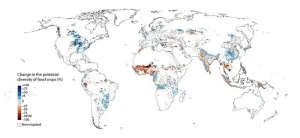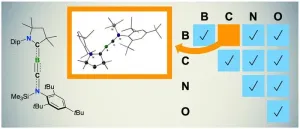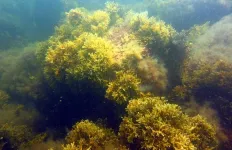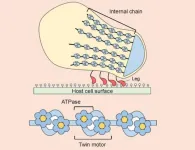(Press-News.org) Creation of a comprehensive genetic representation for more than 2.5 billion people across the Middle East and South Asia could make a major contribution towards advancing precision medicine, a publication in Nature Medicine reveals.
Traditional genetic research has mainly relied on linear reference genomes, which is like having a single, standard version of human DNA that scientists compare everyone's genetic information against. This works well for studying individual genetics but does not capture all the complexities and differences found in diverse populations.
The Arab Pangenome Reference (APR) takes a different approach. Instead of relying on just one "standard" genome, it includes a collection of many different genetic versions specific to the Arab population. This helps scientists see the full picture of genetic diversity, including variations and unique traits that might be missed using the old method.
The international group of researchers led by Dubai Health’s Center for Applied and Translational Genomics (CATG), Mohammed Bin Rashid University of Medicine and Health Sciences, in partnership with the University of Birmingham Dubai published their findings today (4 Mar) in Nature Medicine. Authors included Nasna Nassir, Mohamed A. Almarri, Hosneara Akter, Hamda Hassan Khansaheb, K. M. Furkan Uddin, Ahmad Abou Tayoun, Stefan Du Plessis, Marc Haber, Alawi Alsheikh-Ali and Mohammed Uddin. Nature Medicine is recognized for its rigorous peer-review process and its commitment to disseminating high-quality studies and opinion pieces that advance our understanding of human health.
Professor Alawi Alsheikh-Ali, Deputy CEO and Chief Academic Officer of Dubai Health and Provost of Mohammed Bin Rashid University of Medicine and Health Sciences, commented: “This publication provides a comprehensive and inclusive perspective on human genetic diversity, ensuring that the unique genetic landscapes of the Middle East and South Asia are represented. Integration of these pangenomes into global genomic databases will unlock new discoveries and represents a vital step in advancing health for humanity.”
Professor Yusra Mouzughi, Provost University of Birmingham Dubai commented: “At the University of Birmingham, we pride ourselves on ‘research that changes lives’. This latest research demonstrates the impact of our strong partnership between University of Birmingham Dubai and Dubai Health to deliver research that fundamentally advances science and discovery, creating a new understanding of genetic diversity amongst Arabs and enabling a deeper understanding of the genetic origins of disease.”
Dr. Mohammed Uddin Director of the Center for Applied and Translational Genomics (CATG) at the Mohammed Bin Rashid University of Medicine and Health Sciences, commented: “The APR is the first reference genome constructed to capture the genetic diversity among Arabs. This landmark resource aims to enhance early diagnosis and personalized treatments for genetic diseases that are prevalent in the region. This research uncovered millions of base pairs of novel human DNA sequences, which will contribute to a deeper understanding of the genetic origins of diseases and traits. Our goal is to construct graph pangenomes encompassing the entire Middle East and South Asia, aiming to accelerate the adoption of precision medicine in these regions.”
Co-author Marc Haber, from the University of Birmingham Dubai, commented: “The precision offered by pangenomic approaches is particularly beneficial for studying rare and previously undetected disease-causing variants which paves the way for better understanding and treatment of these conditions, leading to new discoveries in population genetics, disease susceptibility and drug response.”
Professor Stefan Du Plessis, Dean of Research and Graduate Studies at MBRU commented: “At Dubai Health, our Discovery Mission embodies our commitment to innovation, research, and the advancement of healthcare. This publication emphasises the importance of collaborative research in making advanced genomic references a routine part of diagnostics and healthcare. As we move forward, this comprehensive genetic approach promises to reshape our understanding of health and disease, ultimately improving healthcare for millions.
ENDS
For more information, please contact Tony Moran, International Communications Manager, University of Birmingham on +44 (0)782 783 2312 or t.moran@bham.ac.uk. For out-of-hours enquiries, please call +44 (0) 7789 921 165.
Notes to editor:
The University of Birmingham is ranked amongst the world’s top 100 universities institutions. Its work brings people from across the world to Birmingham, including researchers, teachers and more than 8,000 international students from over 150 countries.
‘Advancing clinical genomics with Middle Eastern and South Asian pangenomes’ - Nasna Nassir, Mohamed A. Almarri, Hosneara Akter, Hamda Hassan Khansaheb, K. M. Furkan Uddin, Ahmad Abou Tayoun, Stefan Du Plessis, Marc Haber, Alawi Alsheikh-Ali and Mohammed Uddin is published in Nature Medicine.
Nature Medicine is recognized for its rigorous peer-review process and its commitment to disseminating high-quality studies and opinion pieces that advance our understanding of human health.
Participating institutions:
Mohammed Bin Rashid University of Medicine and Health Sciences, Dubai
University of Birmingham Dubai, Dubai, UAE
Genetics & Genomic Medicine Centre, NeuroGen Healthcare, Dhaka, Bangladesh
University of Dhaka, Bangladesh
Al Jalila Children’s Specialty Hospital, Dubai Health, Dubai, UAE
Dubai Health, Dubai, UAE
GenomeArc Inc., Ontario, Canada
END
Advanced genetic blueprint could unlock precision medicine
2025-03-04
ELSE PRESS RELEASES FROM THIS DATE:
Study: World’s critical food crops at imminent risk from rising temperatures
2025-03-04
Study: World’s critical food crops at imminent risk from rising temperatures
Global food security could be notably impacted by a marked decline in crop diversity if temperatures rise by more than 1.5°C, reveals new research.
Global warming is already reshaping our daily lives, with storms, floods, wildfires and droughts around the world. As temperatures continue to rise, a third of global food production could be at risk. Now, a new study in Nature Food offers a more precise picture of exactly where and how warming will affect our ability to grow food.
Researchers at Aalto ...
Chemistry: Triple bond formed between boron and carbon for the first time
2025-03-04
Boron, carbon, nitrogen and oxygen: these four elements can form chemical triple bonds with each other due to their similar electronic properties. Examples of this are the gas carbon monoxide, which consists of one carbon and one oxygen atom, or the nitrogen gas in the earth's atmosphere with its two nitrogen atoms.
Chemistry recognizes triple bonds between all possible combinations of the four elements – but not between boron and carbon. This is astonishing because there have long been stable double bonds between boron and carbon. In addition, ...
How a broken bone from arm wrestling led to a paradigm shift in mental health: Exercise as a first-line treatment for depression
2025-03-04
OTTAWA, Ontario, Canada, 4 March 2025 – In a comprehensive Genomic Press Interview published today in Brain Medicine, psychiatry resident Dr. Nicholas Fabiano reveals how a personal injury transformed into groundbreaking research on the intersection of physical and mental health. The interview showcases Dr. Fabiano's innovative work in lifestyle psychiatry and his mission to bridge the historical divide between physical and mental wellness.
"The arbitrary line we have drawn between mental and physical health is one of the biggest mistakes in medicine," Dr. Fabiano explains in the interview. His perspective was profoundly shaped by a broken bone due to ...
Alarming levels of microplastics discovered in human brain tissue, linked to dementia
2025-03-04
OTTAWA, Ontario, Canada, 4 March 2025 – In a comprehensive Commentary published today in Brain Medicine (https://doi.org/10.61373/bm025c.0020), researchers discuss alarming new evidence about microplastic accumulation in human brain tissue, providing critical insights into potential health implications and prevention strategies. This Commentary examines findings from a groundbreaking Nature Medicine article by Nihart et al. (2025) on bioaccumulation of microplastics in decedent human brains (https://doi.org/10.1038/s41591-024-03453-1).
The ...
Global neurology leader makes The Neuro world's first open science institute
2025-03-04
MONTREAL, Quebec, Canada, 4 March 2025 - In a comprehensive Genomic Press Interview, distinguished neurologist and geneticist Dr. Guy A. Rouleau, OC, OQ, FRCPC, FRSC, FAAN, outlines his transformative vision for accelerating neurological disease research through open science principles. As Director of The Neuro (Montreal Neurological Institute-Hospital) and Chair of McGill University's Department of Neurology and Neurosurgery, Dr. Rouleau is spearheading a revolutionary approach to scientific collaboration that could fundamentally change how brain disease research is conducted worldwide.
"We must be honest and ...
Alpha particle therapy emerges as a potent weapon against neuroendocrine tumours
2025-03-04
LONDON, UK, 4 March 2025 - In a comprehensive Genomic Press Viewpoint (review) article, researchers are shining a spotlight on a revolutionary approach to tackling neuroendocrine tumours (NETs), a rare but increasingly prevalent form of cancer. Published in Brain Medicine today, a peer-reviewed article titled "Alpha particle therapy for neuroendocrine tumours: A focused review" explores how targeted alpha therapy (TAT) could redefine treatment for patients where surgery is not an option. Authored by Dr. Kalyan M Shekhda, Dr. Shaunak Navalkissoor, and Emeritus ...
Neuroscience beyond boundaries: Dr. Melissa Perreault bridges Indigenous knowledge and brain science
2025-03-04
GUELPH, Ontario, Canada, 4 March 2025 – In an exclusive Genomic Press Interview, Dr. Melissa Perreault reveals how her research is reshaping neuroscience by merging cutting-edge science with Indigenous knowledge. As a professor in the Department of Biomedical Sciences at the University of Guelph and a member of the Royal Society of Canada, Dr. Perreault’s work spans neurobiology, ethical research practices, and the therapeutic potential of psychedelics—all while championing Indigenous representation in STEM.
Raised in a low-income, single-parent household, she was the first in her family to attend university. As she navigated academia, she encountered ...
Giant clone of seaweed in the Baltic Sea
2025-03-04
Researchers at the University of Gothenburg have discovered that what was previously thought to be a unique seaweed species of bladderwrack for the Baltic Sea is in fact a giant clone of common bladderwrack, perhaps the world's largest clone overall. The discovery has implications for predicting the future of seaweed in a changing ocean.
In the brakish waters of the Baltic Sea, bladderwrack is the dominant seaweed species as it is one of the few seaweed species that can tolerate low salinity.
The ...
Motion capture: In world 1st, M. mobile’s motility apparatus clarified
2025-03-04
Mycoplasmas, including bacteria that cause pneumonia in humans, are generally nonmotile, but Mycoplasma mobile, as the species name suggests, has been found in the gills of fish and seems to move by gliding along surfaces. The molecular structure that allows it to do so has for the first time been uncovered by a collaborative research group led by Osaka Metropolitan University Professor Makoto Miyata of the Graduate School of Science.
The OMU-led research team has been working since 1997 to clarify M. mobile’s motility mechanisms. ...
One-third of older Canadians at nutritional risk, study finds
2025-03-04
One-third of Canadian adults aged 55 or older are nutritionally at risk, potentially leading to increased hospital stays, more emergency visits and physician consultations for possible infections, a new study found.
The University of Waterloo researchers assessed data from more than 22,000 community-dwelling adults aged 55 and over from the Canadian Longitudinal Study on Aging. After an initial evaluation, they followed up with participants up to three years later to track their health-service use over the previous year.
Researchers used the SCREEN-8 tool (Seniors ...








